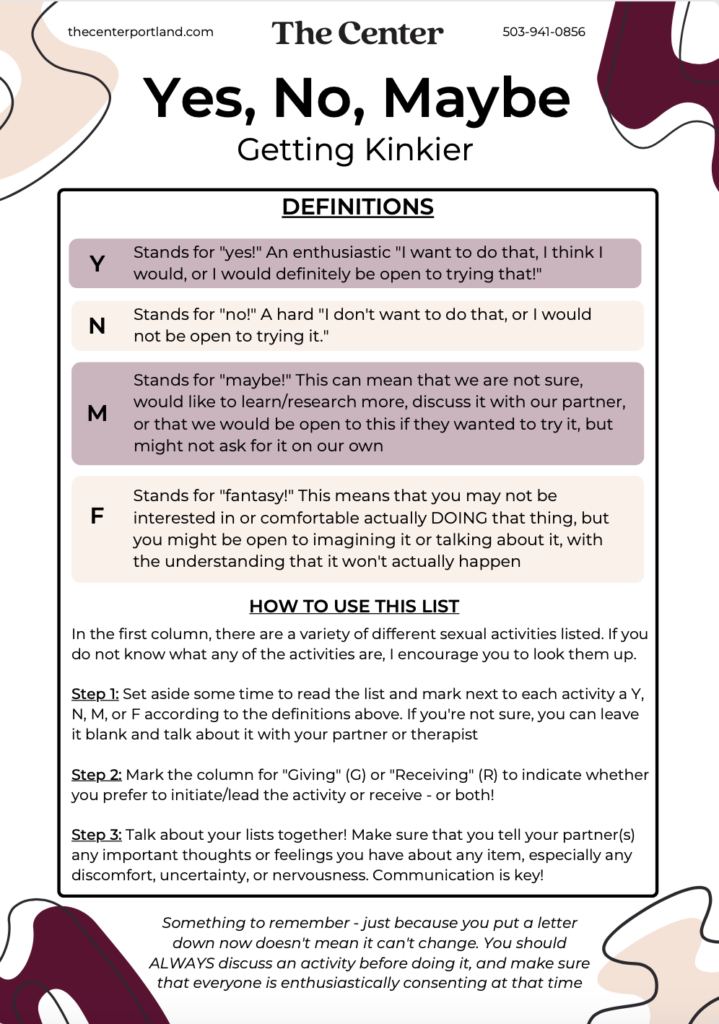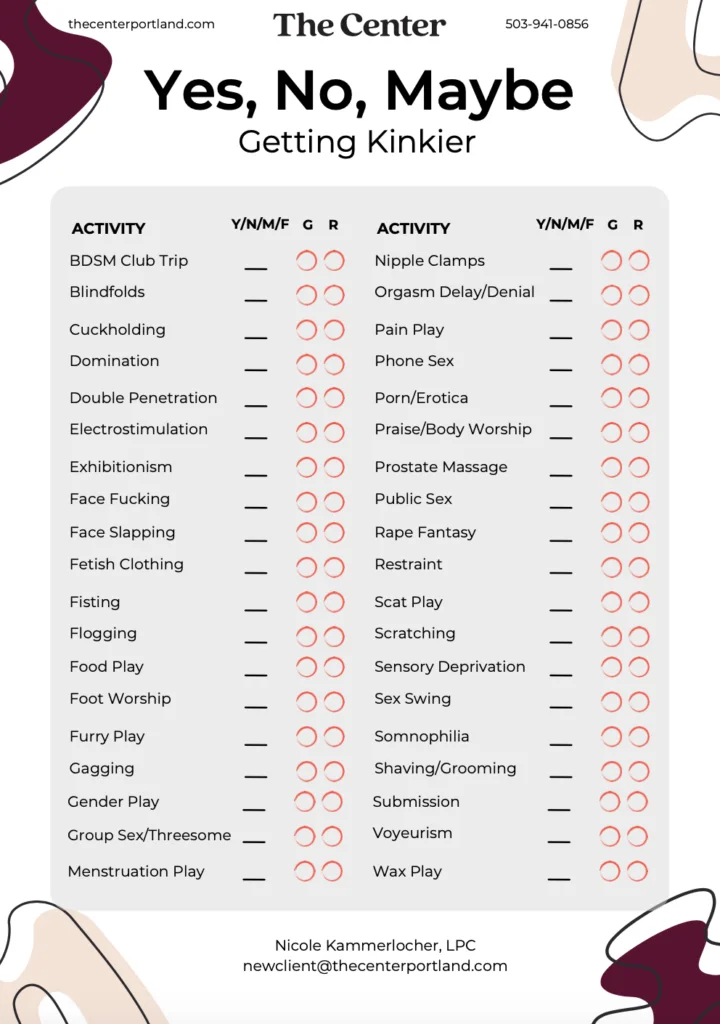Whether you’re a tried and true vanilla couple who is looking to dip your toe into the deeper end of the pool, or an adventurous spirit looking to try white water river rafting, a YNM list can be a great way to get started! In this article, I’ll walk you through the process of using a YNM list to help you and your partner start talking about branching out.
Before you read this article though, if you haven’t read part one, Creating a Roadmap for Sexual Adventure #1: Why is it So F#%!ing Hard to Talk About Trying New Things? and find the idea of talking about your interests and fantasies daunting, I recommend checking it out, or connecting with one of our sex therapists at The Center to help you navigate that process. This article is going to be all about the using a YNM list, and it will only tangentially talk about some of the potholes that can show up on the road to sexual adventure, so if you’re reading this and thinking “Oh God, we would never be able to talk about this!” that might be a sign that a sex therapist could help you learn how to talk about things like this.
Getting Started
The first step is to download the lists and fill them out according to the instructions on the list. Do this when you have your own private time and space, at least 30 minutes to really sit down and think about it.
Talking about the List – Yeses
Okay, so you’ve gone through and marked all your responses, the next step is talking about it with each other! Gulp!
An easy place to start is finding your matching Yeses. Lay your lists next to each other and look at all the places where both people have a yes. It may be tough, but try not to focus your attention on the places where one person has a yes and the other person has a No, Maybe, or Fantasy just yet.
A Yes can mean that I already know I like that and want to do more of it, or it can mean that I definitely want to try that. The most important thing to remember about Yeses is that just because something is a Yes right now, that does not mean that it has to be a Yes forever. You are allowed to change your mind, you are allowed to decide actually, I don’t want to do this!
When we start with our yeses, it can make talking about the Maybes and Nos a little easier. Even if there is something that we have a big YES on and our partner has a No, when we have already gone through and found all our matching Yeses it’s a little easier to accept the disappointment of things where we don’t match, because we still have so many other things that we DO match on.
Talking about the List – Nos
So with the Yeses down, it’s time to tackle the Nos. This can often be the most intimidating part, because it can feel disappointing when we have a Yes to something that our partner has a No to, or vice versa.
Something important to remember is that a No does not mean that your partner is rejecting you or judging you if you are interested in or curious about that thing, they are expressing that they are not interested in it or do not think they would enjoy it. It’s okay to feel disappointed, and it is okay for your partner to feel disappointed, but instead of approaching this feeling like a problem to be fixed, try just making space for it to be an okay feeling to have.
Once you have made some space to talk about any big, difficult feelings coming up in a way that helps you both feel accepted and heard (a tall order I know! If you’re having trouble with this part, talking to a sex therapist can be really helpful), cross the Nos off both of your lists.
These are great things to revisit in your personal fantasies and individual sexual exploration, but when it comes to making plans for what to try together, it is important to respect that our partner doesn’t want to do something. This is where doing the Yeses first comes in handy – now we can turn our attention back to the things we DO match up on!
Talking about the List – Maybes and Fantasies
So the Yeses and Nos are pretty clear cut, right? For Yeses – great! We match! We can get to talking about what we imagine, what we want that to look like, etc. etc. For the Nos, also great! We can talk about any really big discrepancies, hold space for feelings of disappointment, and turn back to our Yeses, Maybes, and Fantasies when we’re ready, but what do those last two even mean?
The Maybe and Fantasy categories are the broadest and most flexible – Maybe can mean anything from “I’m really uncertain and I want to do more research/talk with my partner about what they imagine more before I decide” to “This particular thing doesn’t light my fire, but I would be happy to do it sometimes if my partner is interested.”
Similarly, Fantasy can be a broad category, but the main theme is that this is a category for things you would be interested in talking about, but do not actually want to act out in real life.
The key with these categories is communication – which can be the hardest thing about a YNM list. Talking to your partner about what you want, what you imagine when you put a Maybe or Fantasy, what that means to you, where your boundaries are – these are key conversations to have before we approach actually taking action.
If there’s one thing I want you to take away from this article, it’s how important it is to use the YNM list as a tool to help you and your partner communicate about your interests, desires, and boundaries. This is where you start the conversation, not where you end it. I also want you to know that it’s okay if you are having trouble talking about this.
Most of us do NOT get taught how to talk about sex and relationships, we’re just kind of thrown into the deep end and expected to figure it out, then we get treated like there’s something wrong with us when we don’t know all the answers, and that’s bullshit!
The good news is that sex therapy can provide a really open an empathetic space to help you learn how to talk about sex and your relationship in new ways, and it can provide a healing space for the hurts that not knowing how to talk about these topics and our big feelings about them can cause. If you find yourself struggling with this, you can check out our therapists or email our new client scheduler ([email protected]) to get information about openings.









